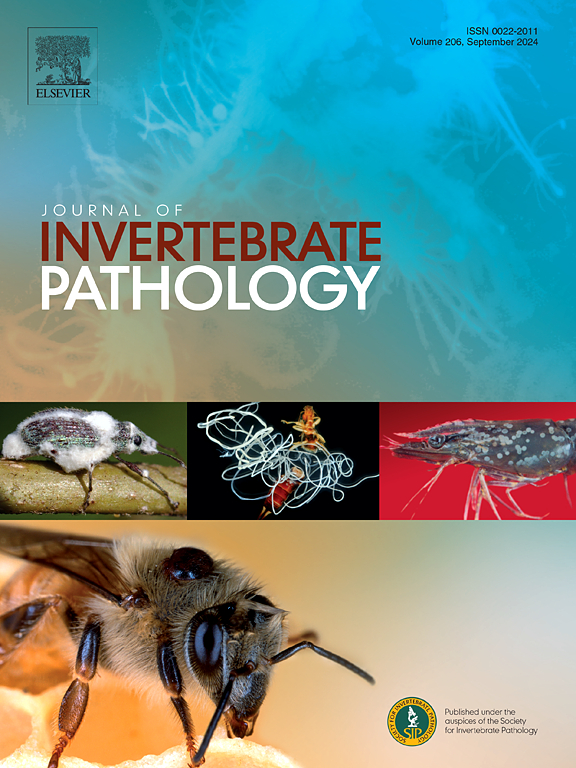Exploring the potential of Trichoderma secondary metabolites against Tetranychus urticae (Acari: Tetranychidae)
IF 2.4
3区 生物学
Q1 ZOOLOGY
引用次数: 0
Abstract
This study aimed to determine 1) the effects of fungal filtrates containing secondary metabolites from five different isolates of four different Trichoderma species (Trichoderma afroharzianum, T. guizhouense, T. harzianum, and T. virens) grown in different liquid media [malt extract broth (MEB), potato dextrose broth (PDB), yeast peptone glucose (YPG), minimal medium (MM), czapek-dox broth (CDB)] on Tetranychus urticae female, and 2) the effects of Trichoderma filtrates obtained from YPG liquid media on the different biological stages of T. urticae in Petri dish and pot experiments. Results showed that the Trichoderma filtrates produced in the YPG medium exhibited the highest mortality rate of 67.6–83.1 % against T. urticae females at 7 days post-application (dpa) compared to other media. In Petri dish experiments, the mortality rates of Trichoderma filtrates on egg, larva, protonymph and deutonymph stages of T. urticae at 7 dpa were 54.0–57.8 %, 71.5–76.0 %, 72.5–79.8 % and 72.8–80.8 %, respectively. Significant differences were observed between the Trichoderma species and control (P < 0.01) but not among the Trichoderma species (P > 0.05). Trichoderma afroharzianum (83 %) and T. virens (84 %) showed the highest mortality rate on T. urticae adult females at 7 dpa and statistically significant differences were observed among Trichoderma species. Pot experiments revealed that the number of viable T. urticae eggs and mobile stages was significantly lower for T. afroharzianum (110.3 eggs, 105.8 mobile stages) and T. virens (118.5 eggs, 115.3 mobile stages) compared to the control (518.9 eggs, 452.5 mobile stages) at 7 dpa. Significant differences were observed between Trichoderma species and control, but not between T. afroharzianum and T. virens. These findings suggest that Trichoderma secondary metabolites are highly effective against economically important pest such as T. urticae, demonstrating their potential as bio-acaricides. Future research should focus on identifying the specific acaricidal compound(s) within these filtrates.

探讨木霉次生代谢产物对荨麻疹叶螨(螨亚目:叶螨科)的拮抗潜力。
本研究旨在确定4种不同木霉菌(非洲木霉菌、贵州木霉菌、哈氏木霉菌和virens木霉菌)的5个分离株在不同液体培养基[麦芽提取液(MEB)、马铃薯葡萄糖肉汤(PDB)、酵母蛋白胨葡萄糖(YPG)、最小培养基(MM)、czapek-dox肉汤(CDB)]中培养的真菌滤液中含有次生代谢物的影响;2)在皮氏培养皿和盆栽试验中,研究YPG液体培养基获得的木霉滤液对荨麻疹不同生物阶段的影响。结果表明,在施用后7 d (dpa), YPG培养基产生的木霉滤液对荨麻雌虫的死亡率最高,为67.6-83.1 %。在皮氏培养皿实验中,7 dpa下木霉滤液对恙螨卵期、幼虫期、原淋巴期和双淋巴期的死亡率分别为54.0 ~ 57.8% %、71.5 ~ 76.0 %、72.5 ~ 79.8 %和72.8 ~ 80.8 %。木霉菌种间与对照间差异极显著(P < 0.01),而木霉菌种间差异不显著(P < 0.05)。在7 dpa时,非洲木霉(83 %)和维伦木霉(84 %)对荨麻疹成年雌虫的死亡率最高,不同木霉种间差异有统计学意义。盆栽试验结果表明,在7 dpa处理下,非洲稻瘟弧菌(110.3个卵,105.8个流动期)和雌稻瘟弧菌(118.5个卵,115.3个流动期)的活虫卵数和活虫期数显著低于对照(518.9个卵,452.5个流动期)。木霉种类与对照间存在显著性差异,而非洲稻瘟霉与绿僵霉间无显著性差异。这些发现表明木霉次生代谢物对荨麻疹等具有重要经济意义的害虫具有很高的防治效果,显示了其作为生物杀螨剂的潜力。未来的研究应集中于鉴定这些滤液中特定的杀螨化合物。
本文章由计算机程序翻译,如有差异,请以英文原文为准。
求助全文
约1分钟内获得全文
求助全文
来源期刊
CiteScore
6.10
自引率
5.90%
发文量
94
审稿时长
1 months
期刊介绍:
The Journal of Invertebrate Pathology presents original research articles and notes on the induction and pathogenesis of diseases of invertebrates, including the suppression of diseases in beneficial species, and the use of diseases in controlling undesirable species. In addition, the journal publishes the results of physiological, morphological, genetic, immunological and ecological studies as related to the etiologic agents of diseases of invertebrates.
The Journal of Invertebrate Pathology is the adopted journal of the Society for Invertebrate Pathology, and is available to SIP members at a special reduced price.

 求助内容:
求助内容: 应助结果提醒方式:
应助结果提醒方式:


